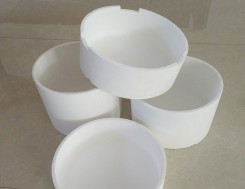

The general production process of quartz crucible is a process of raw material crushing, forming, and firing, among which forming is a key process that has a significant impact on the size and accuracy of the crucible. There are also various methods for molding, today we will learn about the method of injection molding of quartz crucibles:
Injection molding is actually the process of injecting molten plastic from an injection machine into a mold under the thrust of a plunger or screw to obtain quartz crucible products. It originally involved melting solid plastic at a certain melting point and injecting it into a mold at a certain speed through the pressure of an injection machine. The mold was then cooled by a water channel to solidify the plastic and obtain a product similar to the designed mold cavity.

The advantage of this molding method is that it can produce components with uniform structures, accurate dimensions, and complex shapes; The disadvantage is that the mold design process used in the molding process is complex, and it is difficult to eliminate organic additives in the quartz crucible during the drying process.
In addition to the molding process introduced in the article, the other three molding processes for quartz crucibles are injection molding, pressure filtration molding, and injection molding. We will provide a detailed introduction to the above molding methods to compare the advantages and disadvantages of the quartz ceramic products produced by these four molding processes.